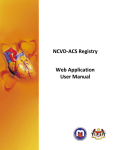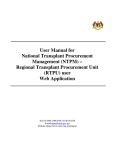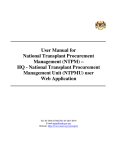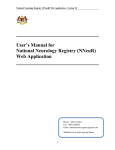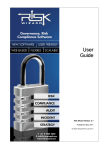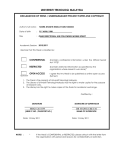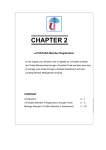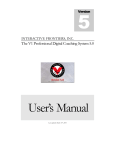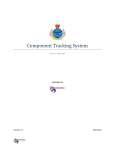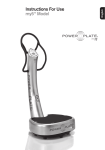Download Web Application User Manual - Association of Clinical Registries
Transcript
NCVD-ACS & PCI Registry User Manual_May2011 National Cardiovascular Disease Database (NCVD) Acute Coronary Syndrome (ACS) Registry Percutaneous Coronary Intervention (PCI) Registry Web Application User Manual NCVD-ACS & PCI Registry User Manual_May2011 | 2 NCVD Web Application Modules Online Data Access and Remote Data Capture Each SDP is given the rights to access their own data and enter data remotely at their site via the eNCVD Web Application. Depending on its rights, each SDP may access one or more of the following eNCVD web application: • Acute Coronary Syndrome (ACS) Registry • Percutaneous Coronary Intervention (PCI) Registry Real-time Report Reports are generated on a real-time basis based on data entered via the online data access and remote data capture module. Data Standard These documents contain the definition of all variables collected in the NCVD registries. Maintenance This module allows user to change their password. Users are responsible for changing their password every time it expires. Security Each authorised user is required to read through, understand, and sign the Security Policy for NCVD Web Application before being authorised to access the application. This is to ensure that users play an active role in ensuring security of data at their level. You need to inform the NCVD RCC immediately if: 1. You change your mobile phone number 2. You lost/ forgot your password and username 3. You are no longer involved in the NCVD 4. You have a change of responsibility or task in the NCVD 5. You are transferred to a different hospital 6. You are transferred to another NCVD-participating hospital ( NCVD-ACS & PCI Registry User Manual_May2011 | 3 How to access the eNCVD web application Register your centre as a Source Data Provider (SDP) with the NCVD Management. Two forms need to be filled in: 1. Authorisation List, 2. Security Policy Fill in the Authorisation List form for the purpose of access control and individually sign the Security Policy form to receive your username and password. Access control Only authorised users, for authorised purposes, can gain access to the system. Depending on the assigned role, different roles have different access rights to the web application; i.e. some user may be able to view data only without the ability to edit the data. Access the NCVD website at www.acrm.org.my/ncvd The NCVD homepage will be displayed as shown in Figure 1.0 Figure 1.0 Homepage of the National Cardiovascular Disease Database (NCVD) Click on Figure 1.1 and the eNCVD welcome page will be displayed as shown in NCVD-ACS & PCI Registry User Manual_May2011 | 4 Figure 1.1 eNCVD welcome page To access the eNCVD web application, key in your username and password in the designated column and click on ‘Sign in’ button. (Note: You are required to change your password every 3 months for security reasons) User authentication There are two levels of user’s authentication. After user logs in using username and password, an SMS containing authentication code will be sent to user’s mobile phone. User then types in the authentication code given in the designated box displayed on Confidentiality Statement page as shown in Figure 1.2 (Note: The password sent via SMS will be different for each new log in) Alternatively, for SDP users with poor phone line reception, type the fixed password (given to you by the NCVD RCC, by request) in the authentication page. Figure 1.2 Confidentiality Statement page Authentication code received via sms The next page brings the user to the Patient List page as in Figure 1.3 NCVD-ACS & PCI Registry User Manual_May2011 | 5 Patient List Patient list shows all of the patients registered by your centre, in a descending order (recently entered patient will be top of the list). Column ‘Reporting Centre’ should show your centre’s name. Figure 1.3 Patient List page Reporting Centre Name of Source Data Provider (SDP)/ Hospital where the patient is admitted. Patient ID (Pt ID) ID which is uniquely given to each patient registered in the registry web. Patient Name Please enter patient’s full name with the correct spelling in capital letters. Old IC In the event that patient doesn’t have MyKad, please enter patient’s Old IC. NCVD-ACS & PCI Registry User Manual_May2011 | 6 MyKad/MyKid Crucial to enter patient’s MyKad as this is the useful criteria used for patient verification. Other ID document no. In the event that patient doesn’t have MyKad or Old IC, please select Other ID Document No. Please specify the type of document from the drop-down box provided (Registration Number, Passport, Birth Certificate, Mother’s I/C, Father’s I/C, Armed Force ID, Work Permit #, Date of Birth, Lab Number, Patient ID, Others) Date of Admission Date patient is admitted to hospital in dd-mm-yyyy format. PCI: Date of Procedure For patients who had undergone PCI, Date of PCI Procedure in dd-mm-yyyy format. NCVD Application User is able to filter patient based on record in ACS or PCI or both. General Information Radio buttons Radio buttons are used for data that requires selection of only one pre-defined value, as shown below. The default value for all radio buttons is assigned to ‘Missing’ unless user chooses otherwise (except fields that are specified otherwise). Check box Check box is used for data field which has either Yes or No values, as shown below. The default value for all check boxes is set to Unchecked unless user chooses otherwise. NCVD-ACS & PCI Registry User Manual_May2011 | 7 Date Picker To prevent user from entering invalid dates, you are to pick a date from the date picker (located next to every date field). If you click on the calendar icon, a calendar will pop up for you to select the respective date. Alternatively, you can also enter the data manually in the text box provided. Click on calendar icon Buttons Each icon represents different functions as defined in Appendix. (Note: Please refer to Icons & Functions) Navigation toolbar There are 7 navigation items in the toolbar on top of each page, where the user could click to do a specific task. These include: i. ii. iii. iv. v. vi. vii. Patient Pending Task Report Data Download (limited access) Change Password Support Logout NCVD-ACS & PCI Registry User Manual_May2011 | 8 Patient This tab can be used to search/ view patient list and add/ register patient. When cursor is placed on the ‘Patient’ tab, dropdown menu is shown as below: a. View Patient (Patient List) To VIEW a patient who has been registered in the database, select ‘Patient List’ under the ‘Patient’ tab. Search patient by filling in the selection criteria and click on ‘Show’ button as shown below: Fill in selection criteria b. Register Patient (Patient Verification) To REGISTER a new patient, select ‘Patient Verification’ under the ‘Patient’ tab. Before registering a patient, please verify that the patient has not been registered in the system before. Below is how you do it: (Note: This is an important step - to avoid any duplication of patient or notification) 1. Click on ‘Patient Verification’ under the ‘Patient’ tab as shown below: NCVD-ACS & PCI Registry User Manual_May2011 | 9 2. SEARCH patient by entering their MyKad and click on ‘Show’ button *This search function will search patients from your centre as well as patients that has been registered in the entire registry from other centres Enter MyKad 3. “Patient Not Found, Kindly check the criteria you have provided…” – means patient is not registered in the system for ACS or PCI. This is where you register/add notification for ACS or PCI by clicking on the button. Fill in accordingly by sections and click on ‘Save’. 4. For existing patients, it will be listed as below: Indicates the number of existing notifications for this patient in the database *Next step for this is to click to ADD new notification (Please refer to ‘Add Notification’) NCVD-ACS & PCI Registry User Manual_May2011 | 10 5. However, ability to view/edit differs by user, depending on the access given: For user with access to ACS ONLY: can view/edit ACS, but will not be able to click on PCI notification (dimmed) For user with access to PCI ONLY: can view/edit PCI, but will not be able to click on ACS notification (dimmed) For user with access to BOTH applications: can view/edit for both 6. To ENTER DATA, select the appropriate application (ACS or PCI), click on notification To add new notification click on . Same steps apply for both ACS and PCI. . Add new ACS notification by clicking on the button Shows patient has 2 ACS admissions (vice versa for PCI) NCVD-ACS & PCI Registry User Manual_May2011 | 11 7. Enter data accordingly and click on ‘Save’ button once completed (Note: For existing patient, Section 1 is prefilled based on their previous admission. To edit Section 1, please refer to c. Edit Patient Demographics) Fields marked with *asterisk are mandatory to be filled in. Failed to do so, user won’t be able to save the data. System will prompt user as shown below: c. Edit Patient Demographics (Section 1) 1. To edit Section 1 Demographics, click on icon (Patient List). NCVD-ACS & PCI Registry User Manual_May2011 | 12 2. Update/ edit where necessary and click on ‘Save’ button once completed Request to Delete User can request to delete their entry if they’ve mistakenly duplicated the patient’s data. Click on ‘Request Delete’ and you will see the summary page of requests to delete by your centre. Page will list ‘Total records’ of requests to delete by applications (ACS or PCI patients) and forms (notifications, follow ups). Click on ‘Click to View List’ to see the full list a. Request to Delete Notification 1. To request delete notification, simply click on for the specified notification ID NCVD-ACS & PCI Registry User Manual_May2011 | 13 Selected notification to delete 2. Check if this is the notification that you want to delete. State your reason for request delete in the designated box. Click on ‘Request Delete’ button 3. Next page will show the specific notification in faded font to indicate that this notification has been requested to be deleted. Once requested to delete, the ‘Update’ icon will not be available NCVD-ACS & PCI Registry User Manual_May2011 | 14 4. Send email to the NCVD RCC for documentation purpose. Standard email as below: Email to: [email protected] OR [email protected] Details to include in email: 1) SDP 2) Patient Name 3) MyKad 4) Patient ID 5) Notification ID/ Lesion ID 6) Reason for deletion b. Request to Delete Patient ID Each patient registered in the registry web is given one unique Patient ID throughout the country. This is where patient verification steps are important to avoid duplication of Patient ID. Below example of Patient ID duplication where few Patient IDs share the same MyKad number: Selected Patient ID to delete 1. Please follow the steps shown in ‘Request to Delete Notification’ 2. Email to the NCVD RCC for further action. Please refer to the standard email. c. Request to Delete Lesion (PCI) 1. To request delete lesion, go to Section 7 and select the appropriate lesion to delete. NCVD-ACS & PCI Registry User Manual_May2011 | 15 2. Click on and the next page will show where you have to state your reason for request to delete. Next click on ‘Request Delete’ button 3. Next page will show the particular lesion is dimmed with no option to update. Please contact the NCVD RCC if you need to undo your request to delete (eg. mistakenly clicked on the button) c. Request to Delete Follow Up 1. To request delete follow up, identify the correct notification and click on ‘Follow up’ column icon in the NCVD-ACS & PCI Registry User Manual_May2011 | 16 2. State your reason to delete follow up and click on ‘Request Delete’ 3. Next page will show the particular Follow Up is dimmed, to indicate that user has requested to delete this follow up Notification Form Before entering data, please make sure that the ‘Name of Reporting Centre’ is the NAME OF YOUR CENTRE. Calendar button is available to add the admission date. Date of admission is default to current date. PLEASE CHANGE THE DATE ACCORDINGLY. Remember that if the application is left idle for more than 60 minutes, the application will be logged off automatically. The timer is displayed at the top left of the page viewed and counts down the 60 minutes as shown below: NCVD-ACS & PCI Registry User Manual_May2011 | 17 ACS Notification The notification form consists of 11 different sections that need to be filled in. Section 1 is compulsory to be filled in. Complete all sections (Section 1 to 11) and click ‘Save’. PCI Notification The notification form consists of 9 different sections that need to be filled in. Section 1 is compulsory to be filled in. Complete all sections* and click ‘Save’. * For PCI, the notification form needs to be filled in the following order: 1. Section 1 until Section 6 2. Followed by Section 8 and Section 9 3. Go back and fill in for Section 7 – fill in details for EVERY LESION treated NCVD-ACS & PCI Registry User Manual_May2011 | 18 PCI Notification – Lesion (Section 7) a. Add Lesion 1. For Section 7 PCI Procedure Details, please fill in the ‘Lesion Number’ and click on ‘Add Lesion’ 2. Once done, AutoLesion ID will be generated in the PCI Lesion List below according to the ‘Lesion Number’ keyed in. One AutoLesion ID represents one lesion 3. To add new lesion, simply click on ‘Add Lesion’. Lesion page will appear as below: One diagram represents only one lesion. Please identify the subsequent lesion on a new diagram/ lesion page. Click ‘SAVE’ once form is completed. NCVD-ACS & PCI Registry User Manual_May2011 | 19 b. Add or Edit Info on Lesion 1. To add or edit information on lesion, go back to the PCI Lesion List (Section 7) and click on c. Stent Details 1. Stent details for lesion – choose stent type from the ‘Stent Code’ drop-down box as shown below: Select stent type 2. Once stent type is specified, pick the stent code/ name from the subsequent drop-down box. Pick option ‘Others’ if you cannot find the stent code/ name in the list available, and specify accordingly Select stent code/ name NCVD-ACS & PCI Registry User Manual_May2011 | 20 Follow Up Forms PCI Follow Up (30 days, 6 months or 12 months) Add Follow Up 1. Select which patient notification that you wish to add follow up and click on the follow up icon 2. Determine the follow up duration: 30 days, 6 months or 12 months? Fill in accordingly and click on ‘Save’ button once completed entry Select FU duration 3. Next page will show the follow up has been added to the notification NCVD-ACS & PCI Registry User Manual_May2011 | 21 Follow Up Forms ACS Follow Up (30 days or 1 year) Add Follow Up 1. Select which patient notification that you wish to add follow up and click on the follow up icon Select notification to add FU 2. Determine the follow up duration: 30 days or 1 year? Fill in accordingly and click on ‘Save’ button once completed entry Select FU duration 3. Next page will show the follow up has been added to the notification NCVD-ACS & PCI Registry User Manual_May2011 | 22 Common problem Unable to Add Notification (for ACS & PCI) Normally user will face this problem if patient is recorded as ‘Died’ in the system and user tried to enter retrospective data. There won’t be any icon to add notification. What do you need to do? Contact or email to the NCVD RCC with the required details and we will guide you on the next step. Standard email to the NCVD RCC to address this matter: Email to: [email protected] OR [email protected] Details to include in email: 1) SDP 2) Patient Name 3) MyKad 4) Patient ID 5) ACS/PCI Audit This section is useful to keep track of the last person who did the changes to the information. PCI ACS NCVD-ACS & PCI Registry User Manual_May2011 | 23 Icons & functions Different icon represents different functions: Icon Function Icon Function To show number of notification To show record has been requested to be deleted To Add New record To Add Follow Up To View existing record Calendar icon To Edit/ Update record Instant data definition To Request to Delete record Mandatory field Different color to differentiate time frame Description Blue Buttons for Notification Red Buttons for Follow Up Green Buttons for Outcome Figure Function Non-editable text box Editable text box, requires manual data entry Drop-down box - select input from the list provided Manually enter data or pick from the calendar provided To view all records that fulfill the criteria entered To show all records (ignoring any criteria entered) NCVD-ACS & PCI Registry User Manual_May2011 | 24 Helpdesk support For assistance in completing your application for access or if you experience technical difficulties while using the web application, including problems related to data entry; please contact: NCVD Registry Coordinating Centre (RCC) Personnel S Gunavathy Selvaraj (Registry Manager) Noor Amirah Muhamad (Registry Associate) Email: [email protected] Email: [email protected] The NCVD Management Office Contact 03-4023 1500 Fax 03-4023 9400 Address National Cardiovascular Disease Database (NCVD) c/o National Heart Association of Malaysia (NHAM) Heart House, First Floor, Medical Academies of Malaysia 210 Jalan Tun Razak, 50400 Kuala Lumpur, MALAYSIA NCVD-ACS & PCI Registry User Manual_May2011 | 25 Notes Note: The NCVD User’s Manual for NCVD-ACS & PCI Registry Web Application is subject to future amendments for better quality of the NCVD. © National Cardiovascular Disease Database (NCVD) Prepared by: NCVD Management Team, May 2011 Strictly for training purposes only NCVD-ACS & PCI Registry User Manual_May2011 | 26 NCVD-ACS & PCI Registry User Manual_May2011 | 27



























